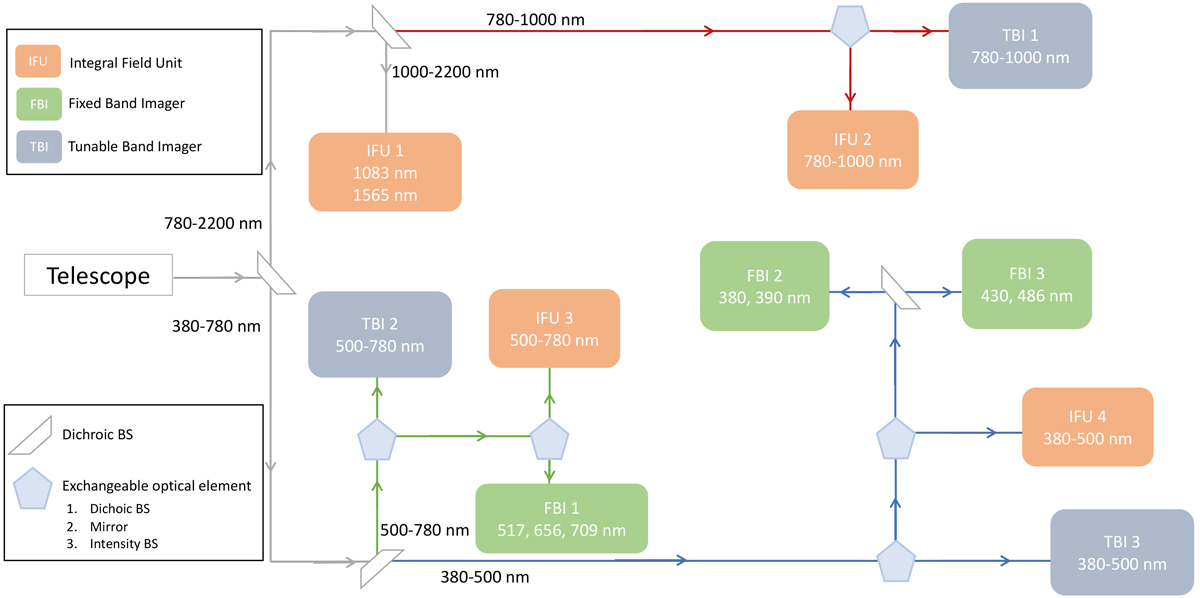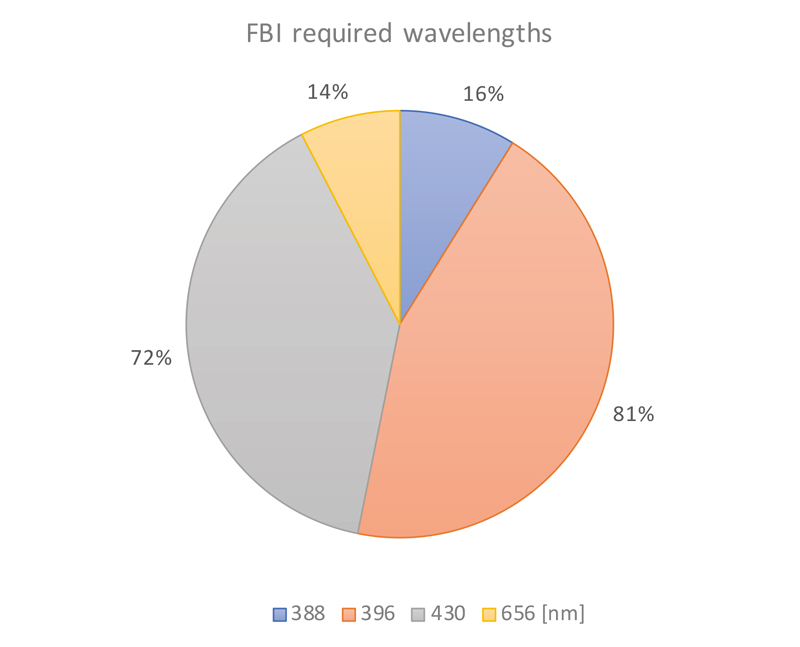In the last months, the EST Project Office has worked on the definition of the EST light distribution system and instrument suite, using the guidelines laid down by the Science Requirement Document.
 Figure 1. Spectral lines required by the observing programs in the SRD
Figure 1. Spectral lines required by the observing programs in the SRD
The Science Advisory Group (SAG) delivered the Science Requirement Document (SRD) to the EST Project Office (PO) in December 2019 and also made it publicly available on arXiv.The SRD provides information on the science to be done with EST. A total of 61 science cases are presented in the SRD. More importantly, there is a section that groups the main observational requirements through 93 Observing Programs (OP). There, the SAG specified the required measurements in detail, e.g. which wavelength regions need to be observed, what types of instrument should be used, their spatial resolution, their cadences, etc.
The information provided by the SRD is essential to define the light distribution system and the instrument suite of EST. This can be done using the OPs as a baseline and trying to satisfy as much as possible the observational requirements. In this article, we present results from a statistical analysis of the OPs and a proposal for the light distribution and the instrument suite of the telescope. The EST PO presented these preliminary designs to the SAG on June 3rd, 2020 to receive feedback. After that, the EST PO will proceed to the next phase where the specifics of the instruments and the optical elements in the light path will be defined.
OP statistics. We started the statistics of the OPs analysing the different spectral regions requested in the SRD. We show the results in Figure 1, where we can see that there are certain regions that are much more demanded than others. In particular, the Ca II spectral line at 854 nm is requested in 80% of the observing programs. There are additional lines that follow in popularity, like He I 1083 nm, the Fe I pair at 630 nm, and the Ca II H and K transitions in the blue at 390 nm. In addition, there are various OPs that request to observe those spectral lines at the same time. In particular, the most common scenarios are Ca II 854 nm (in general with He I 1083 nm), together with a photospheric line at 630 nm (sometimes at 1565 nm instead) and context images in Ca II H at 390 nm. These results are the baseline for the light distribution system proposed by the EST PO.
Light distribution. Figure 2 shows the light distribution design based on the previous results. The solar light comes from the left and enters the telescope. It is divided by an optical element, i.e. a dichroic beamsplitter, that sends part of the spectrum to a first arm and the rest to a second arm. In this case, we are not reducing the intensity of the spectrum, just dividing the spectral range. This process is repeated again to create red and near-infrared arms (top dichroic) and visible and blue arms (bottom dichroic). The reason for dividing the light in four is based on the results presented in Figure 1. This design allows multi-wavelength observations to be performed. In particular, observers can have access to the Ca II 854 nm and He I 1083 nm lines simultaneously. It also makes it possible to have the most demanded photospheric lines –the Fe I pair at 630 nm– and the requested context chromospheric observations at 390 nm in separate instruments. Therefore, those transitions could be observed strictly simultaneously for the first time ever in any solar telescope.

Instrument suite. After designing how the light is distributed in wavelength, the next step is to define the instruments we will have in each spectral arm. To that end, we checked the OP tables in the SRD again, focusing this time on different aspects. For instance, we checked how the community wants to observe the Ca II 854 nm and He I 1083 nm lines. In both cases, more than 75% of the OPs want to use an Integral Field Unit (IFU) instrument, while the rest of cases requested to observe the spectral lines with Tunable Band Imager (TBI) instruments. Moreover, a similar ratio of instruments was found for the visible photospheric lines at 630 nm. Thus, we decided that we should have one IFU system per arm in the visible, red, and the infrared. On top of that, we thought that we should include a fourth IFU in the blue to perform seamless multi-wavelength observations with state-of-the-art IFU systems (orange boxes in Figure 2). In fact, EST is going to be the first telescope equipped with one IFU system per spectral region. Currently, microlens arrays and image slicers are the two IFU systems baselined for EST.
After that study, we examined the statistics related to the context instruments, the so-called Fixed Band Imagers (FBIs). We found that most of the OPs request to use FBIs in the blue and visible arms (see Figure 3). Thus, we considered that we should have instruments in those regions only. At the same time, we also found that most of the OPs require simultaneous observations of the photosphere at 430 nm and the chromosphere at 390 nm. Therefore, we propose to have two instruments in the blue, allowing for the possibility of strict simultaneity between these two spectral regions (see the green boxes in Figure 2).
The next step was to define the TBI instruments. They are less requested than IFU systems (45% vs 65% of the OPs) but these are the only instruments that can provide a large field of view (FOV), e.g. 40x40 arcsec2, with high spatial resolution, complementing the limited FOV of IFU systems. Aiming to fulfil the seamless multi-wavelength coverage philosophy of EST, we decided to go for one TBI per arm. We did not see a strong demand in the infrared arm, neither at 1083 nor at 1565 nm, we did not include a TBI in that arm, defining a system with 3 TBIs instead (blue boxes in Figure 2). Finally, there is a low demand for traditional long-slit spectrographs and we opted to propose a design without them.

Regarding how the light is distributed within each of the arms, we included a pentagon symbol to represent up to three different optical elements depending on the observer's needs. The pentagon could be a dichroic beamsplitter (like the white trapezoids) that sends part of the spectrum to one instrument and the rest to the other. It could also be a mirror (or nothing at all), sending all the light to one single instrument.
Finally, it could be an intensity beamsplitter that sends the same wavelength range (with a different amount of intensity) to two different instruments. In this way, following the EST philosophy we provide the users with the largest number of combinations possible so we do not limit the type of observations they can perform with EST. These optical elements will be exchangeable and we foresee that they will be set up at the beginning of every campaign.
